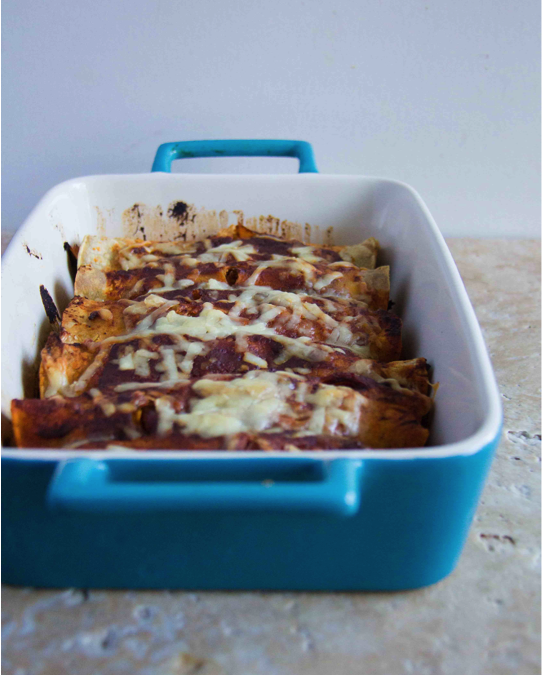
by Tomato Wellness | Jul 26, 2019 | Recipes
Dinner is served thanks to this amazing recipe for Roasted Brussels Sprouts & Chicken Enchiladas. Be sure to make extras because they will be gone in a heartbeat!
It’s always a good time for enchiladas. Is it weird to wrap up enchiladas with little, baby cabbages inside? I say no. This is mainly because lately I’ve been living in a Brussels sprouts obsessed phase. And also because it’s always a good time for enchiladas, whether they’re filled with little green Brussels sprouts or not. No judgment here. I accept all the enchiladas.
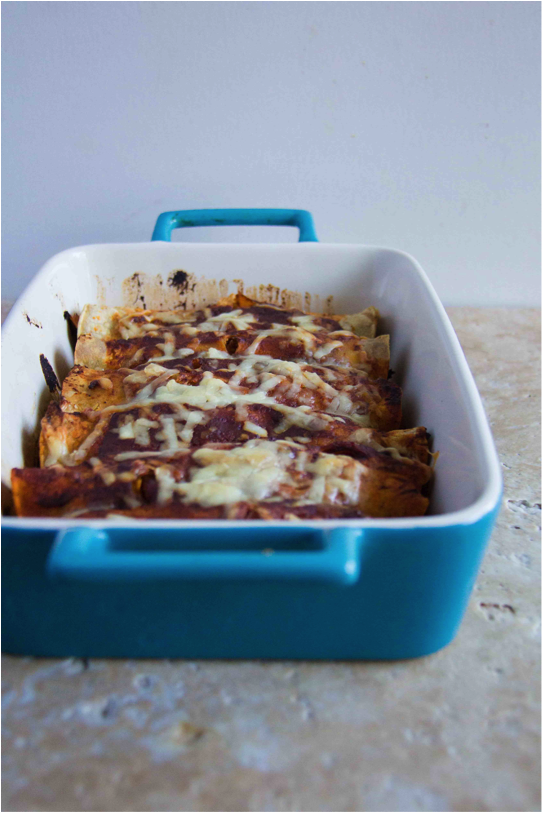
There’s this thing about crispy oven-roasted Brussels sprouts that just does it for me. Actually oven-roasted veggies in general just do it for me. Oven-roasted carrots with a pinch of sea salt + honey. Oven-roasted tomatoes topped with Parmesan + basil. Umm yeah.
Tomatoes just have this magical way of getting all caramelized and sweet when roasted. A can of roasted tomatoes can do wonders to a plain ol’ pizza crust. Really, tomato anything can do wonders for a dish. Not to mention the powerhouse nutrient lycopene, which tomatoes are bursting with.
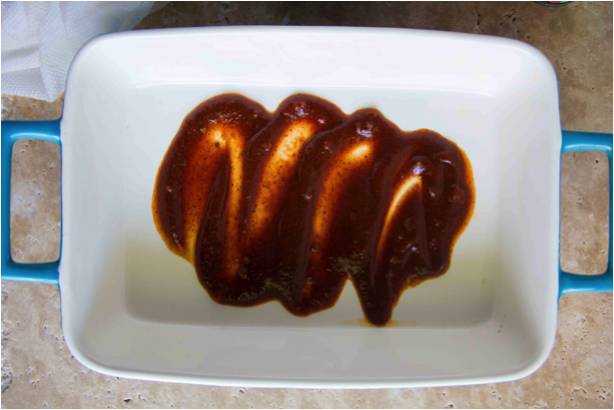
I buy a lot of tomato paste. It’s one of those pantry staples just necessary for life. So many recipes call for a delicious addition of tomato-y goodness. Enchilada sauce, pasta sauce, pizza sauce, soups, stews…they all NEED it. This article on how to save leftover tomato paste has spared quite a few half empty cans of the stuff.
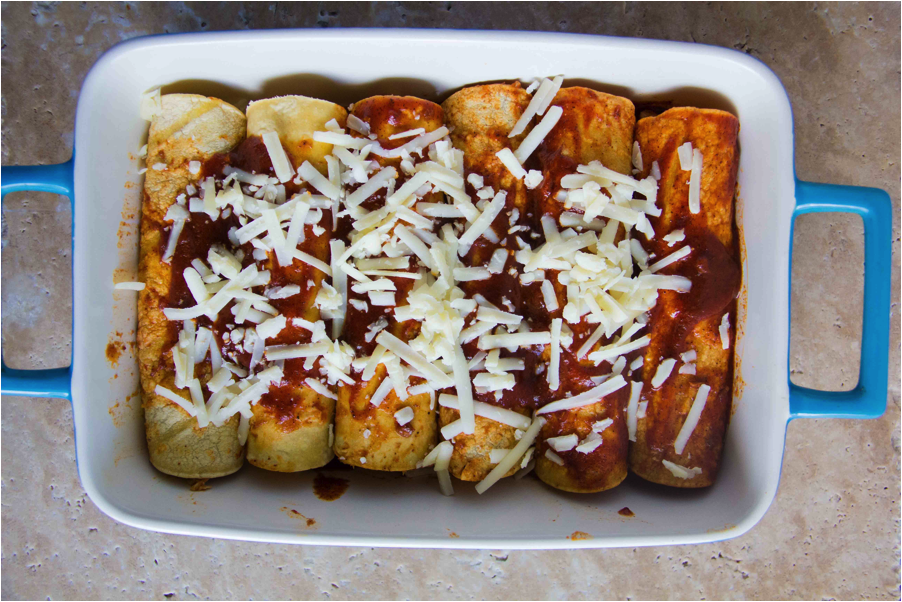
So for this recipe I filled enchiladas with mashed acorn squash, which makes them oh-so-creamy without being super heavy and cheesy. A little of extra sharp cheddar on top adds plenty of cheesy goodness. Pair that with the sweet enchiladas sauce and you’ve got yourself a perfect dinner.
Ingredients
Enchilada Filling
-
2 chicken breasts, cooked & shredded
-
1 small acorn squash, sliced in half and seeds scooped out
-
2 cups fresh Brussels sprouts (~18 balls), quartered
-
½ teaspoon chili powder
-
¼ teaspoon cumin
-
¼ teaspoon salt
-
¼ teaspoon black pepper
-
12-14 (6-inch) corn tortillas
-
½ cup extra sharp white cheddar, grated
Enchilada Sauce
-
3 tablespoons olive oil
-
2 garlic cloves, minced
-
1 tablespoon + 2 teaspoon chili powder
-
2 cups reduced-sodium chicken broth
-
6-ounce can tomato paste
-
1/4 teaspoon salt
Instructions
- Preheat oven to 375F.
- Line a rimmed baking sheet with foil and place acorn squash cut side down. Bake for 40 minutes, or until soft.
- While baking, toss the quartered Brussels sprouts with olive oil, salt and pepper. Spread onto a separate baking sheet and place in the oven. Bake for 30 minutes, stirring twice throughout cooking.
- While baking, make your enchilada sauce. Heat olive oil in a saucepan over medium heat. Add in garlic and stir until garlic turns golden brown, about 1 minute. Add in chili powder and stir for 1 minute. Add in chicken broth, tomato paste and salt. Bring to a boil, reduce to simmer and cover.
- Scoop flesh out of the acorn squash into a large bowl. Add in shredded chicken, roasted Brussels sprouts, chili powder, cumin, salt and pepper.
- Now assemble your enchiladas. Wrap your tortillas in a damp paper towel and heat for 30 seconds in the microwave to make them pliable. Scoop ¼ cup enchilada sauce into the bottom of a casserole dish (I had to use 2 baking dishes).
- Lightly coat a tortilla with enchilada sauce, add some filling and roll up the enchilada. Repeat until tortillas and filling are all rolled up. Pour remaining enchilada sauce over the top of the enchiladas. Sprinkle with cheese.
- Bake at 375F for 35-40 minutes. Just before serving, place under the oven broiler for 30 seconds to get the cheese all crispy.

Kylie is a food blogger and dietetic intern living in Houston, TX. Her recipes try to make healthy eating something to look forward to. While healthy eating is important, Kylie is a huge fan of everything in moderation…including moderation. You can connect with Kylie on instagram, twitter, facebook, bloglovin or pinterest.
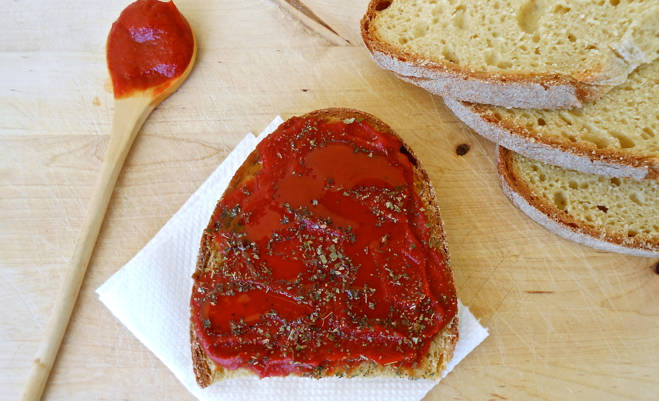
by Tomato Wellness | Jul 24, 2019 | Food and Nutrition
Tomato Paste, a Mediterranean Staple and Why You Should Use It
Tomato paste is a a Mediterranean staple! Learn more about why you should use it in the kitchen with this information blog from dietitian Elena Paravantes.
by Elena Paravantes, RD
In my mother’s descriptions of my grandmother’s cooking and her own, one ingredient would come up that seemed odd to me: tomato paste. I would wonder: why would you use all these fresh ingredients and then add a canned tomato product?
Well, in the olden days it served a purpose: it was used as a substitute for tomatoes, when fresh ones were not available. Tomato paste was made at home as a way to preserve tomatoes to use during the winter. I read somewhere that tomato paste originated in Italy and and then its use spread across other areas of the Mediterranean, which makes perfect sense considering how important tomato is in the Mediterranean cuisine.
My mother remembers as a little girl in the 50’s, going to the local deli (in Greece) and getting 1-2 tablespoons of the stuff on a piece of wax paper so her mother could use it for cooking. What did they do with it? Well they made the known kokkinista, which translates as the “red ones”. These are dishes either made with tomatoes or tomato paste, hence the name referring to the redness.The tomato paste along with olive oil is warmed up (or almost sautéed) in a pot or pan, and the vegetables or meat are added and cooked. Of course it is also used in pasta and sauces and basically when you want to give a little color or added flavor.
Nowadays you can get tomatoes year round (not great tasting ones though) or use canned tomatoes, so why not use that instead? My mom noted that using the paste really gives a different, unique flavor that you just can’t get with fresh tomatoes or canned tomatoes. And why not? Nutritionally, you will get plenty of benefits with tomato paste.
Tomato paste basically consists of cooked tomatoes that are strained. Studies have shown that processed tomato products such as tomato paste have higher levels of lycopene, an antioxidant known for its protective effect against some forms of cancer and also promoting skin health. But tomato paste is not what I would consider a processed product (in the bad sense), it is just heated and strained, containing only tomatoes and sometimes salt (no preservatives or sugar). In addition, when adding olive oil, as is common in Greek cooking, not only do you get the good monounsaturated fats and olive oil antioxidants, but the presence of fat increase the absorption of the antioxidants in the tomato. And if you are cooking with tomato paste you get an additional benefit: heating tomato paste with olive oil increases antioxidant activity.
A Quick Snack
My mother recalls the “poor” children getting a large slice of bread with tomato paste, drizzled with olive oil and sprinkled with oregano – a wonderful snack full of antioxidants from the tomato paste, olive oil and oregano plus good fats. The rich kids would get a slice of bread too, but with butter, sprinkled with sugar as those ingredients were more expensive and only people who had money could get them. How ironic, considering that the poor kid’s snack was so much healthier than the rich kid’s snack. Poor or not, I love that snack and my mom would give it to us slightly altering it and calling it “pizza”: bread brushed with olive oil and tomato paste, sprinkled with oregano and some shredded cheese, baked in the oven for 5 minutes.
Registered Dietitian
Award winning Registered Dietitian, Nutritionist and Writer specializing in the Mediterranean Diet. She has been active in the field of food and nutrition for over 15 years as a clinical dietitian, food and nutrition consultant, writer, teacher and lecturer, both in the U.S. and in Greece. Elena firmly believes in the wide-ranging health benefits of the Mediterranean Diet and is committed to educating the public about the wholesome food plan she grew up with through her writing, teaching and lecturing.
To learn more, check out Elena’s website: OliveTomato
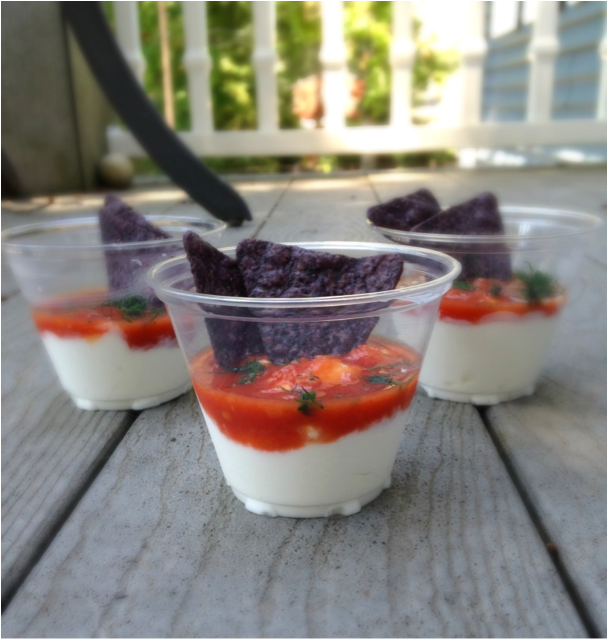
by Tomato Wellness | Jul 3, 2019 | Food and Nutrition
A Red, White, & Blue 4th of July
Go red this 4th of July with canned tomatoes! Invite over some friends and celebrate good health with a simple, nutritious red, white, and blue appetizer from dietitian Sharon Palmer.
By Sharon Palmer, RD, author of Plant-Powered for Life
This 4th of July, let’s remember where our food roots come from. Most traditional, cultural diets—whether from Peru or Asia—are based on plants. Even in our own country, our diet once gravitated more towards plants. My mother, who grew up in Arkansas, enjoyed a wholesome plant-based diet; a typical meal was black-eyed peas, foraged greens, roasted tomatoes, and cornbread. It’s amazing to think about how far we’ve strayed away from a plant-centric diet in the United States in recent years.
Now when we think about most foods in the “Western diet,” we tend to think of foods characterized by large amounts of animal products, and few whole plant foods. It’s no surprise that this eating style has been linked with our current epidemic of chronic disease and obesity.
But there’s good news.
Many of America’s favorite foods can be made by better-tasting and better-for-you by piling on America’s favorite condiments – tomato products, including salsa, ketchup, and tomato sauce.
So healthy are tomato products that high intakes have been associated with important health benefits, including reduced risk of certain chronic diseases, such as heart disease and some forms of cancer, according to a 2012 study in the American Journal of Clinical Nutrition. And the best part is that there’s no need to break the bank to redeem the health benefits associated with tomato products. According to the Journal of the Academy of Nutrition and Dietetics, sweet potatoes, white potatoes, tomato juices and tomato soups, carrots, and broccoli all scored the highest Nutrient Rich Foods (NRF) index per dollar. NRF is based on nine nutrients to encourage: protein; fiber; vitamins A, C, and E; calcium; iron; magnesium; and potassium; and on three nutrients to limit: saturated fat, added sugar, and sodium.
So, this 4th of July, invite over some friends and celebrate good health with this simple, nutritious red, white, and blue appetizer, made better by tomato products!
Red, White & Blue Salsa Cups
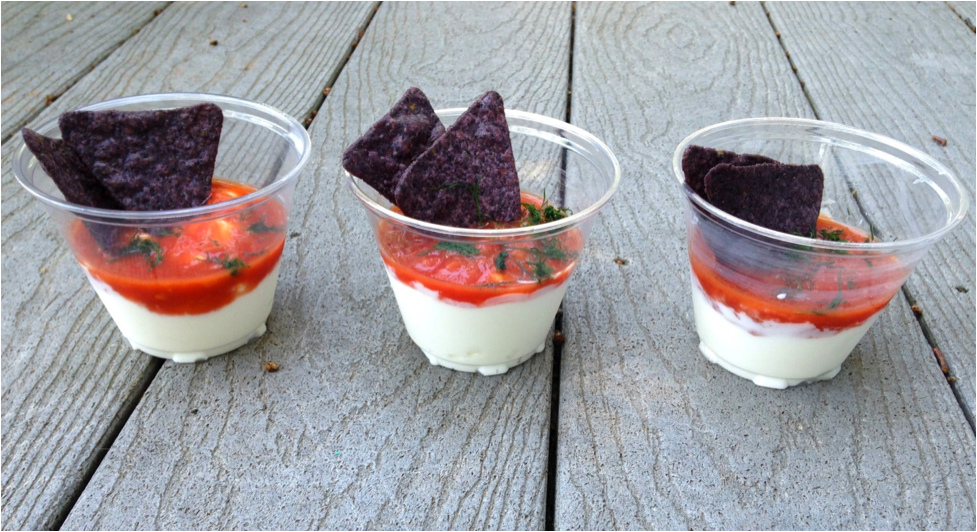
Ingredients:
- 1 12-ounce can of salsa
- 16 ounces of non-fat plain Greek yogurt (2, 8-ounce containers)or vegan sour cream (recipe here)
- 1 package of blue corn tortilla chips
- 16 plastic cups
Instructions:
- In each plastic cup, layer ~ ¼ cup of non-fat Greek yogurt, followed by 2 tablespoons salsa.
- Garnish with two tortilla chips.
- Store in the refrigerator until serving and serve with chips.
Makes around 6-8 individual dips.
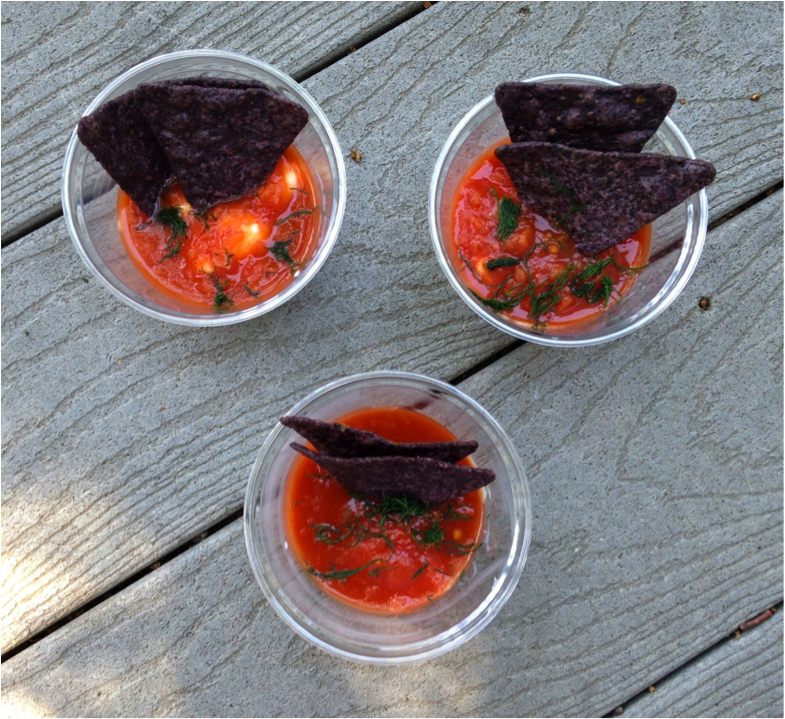
Writer and Author of The Plant-Powered Diet

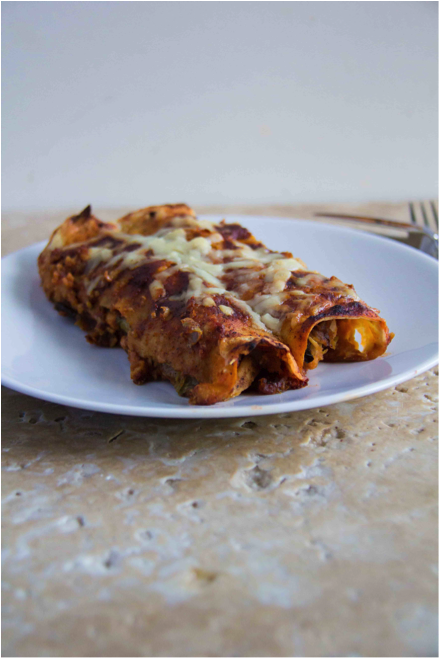






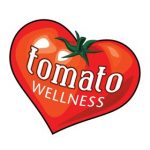



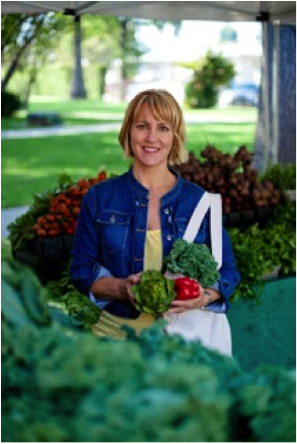
Recent Comments